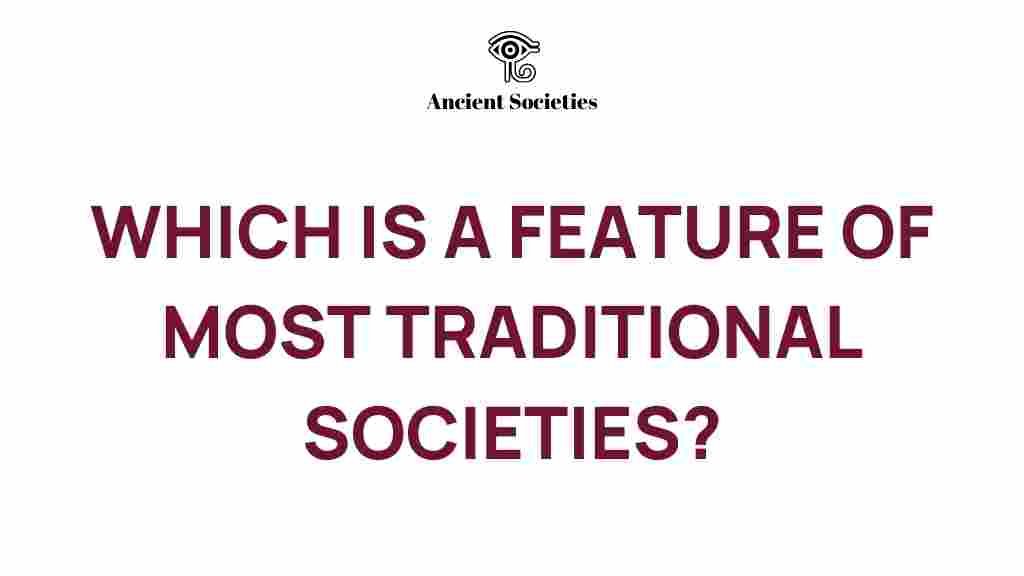Unveiling the Common Thread: Features of Traditional Societies
Traditional societies are often characterized by their rich cultural heritage, deeply rooted social structures, and strong community values. Understanding these societies involves exploring the customs, rituals, economic systems, and familial roles that define their way of life. In this article, we will delve into the common features of traditional societies and how they continue to influence the modern world.
Introduction
In an age of rapid globalization and technological advancement, traditional societies offer a fascinating glimpse into the past. These communities maintain customs and practices that have been passed down through generations, providing a sense of identity and continuity. By examining the various elements that make up traditional societies, we can appreciate the importance of preserving cultural heritage and the lessons they offer for contemporary society.
Understanding Traditional Societies
Traditional societies are often defined by their adherence to long-standing customs and practices. Here are some key features that contribute to their uniqueness:
- Cultural Heritage: The beliefs, languages, and artistic expressions that define a community.
- Social Structures: The organization of society, including roles and hierarchies.
- Community Values: The shared ideals and ethics that govern behavior.
- Customs and Rituals: The practices that mark significant events and transitions in life.
- Economic Systems: Traditional methods of production and trade.
- Familial Roles: The expectations and responsibilities of family members.
Cultural Heritage
The cultural heritage of traditional societies encompasses the history, art, and values that shape their identity. This heritage is often expressed through:
- Languages: Many traditional societies speak languages that are unique to their culture, which can reflect their worldview.
- Art Forms: Traditional art, music, and dance play a crucial role in cultural expression and storytelling.
- Folklore and Myths: Stories passed down through generations that convey moral lessons and cultural values.
Social Structures
The social structures of traditional societies are often hierarchical, with roles defined by age, gender, and lineage. This organization helps maintain order and continuity. Key aspects include:
- Leadership: Elders or chiefs often hold authority and are responsible for decision-making.
- Gender Roles: Specific roles for men and women, often based on physical capabilities and cultural expectations.
- Community Participation: Everyone plays a role in the functioning of the society, from children to elders.
Community Values
Community values are the bedrock of traditional societies, guiding interactions and behaviors. These values often emphasize:
- Collectivism: The needs of the community are prioritized over individual desires.
- Respect for Nature: Many traditional societies have a deep connection to the land and natural resources.
- Intergenerational Support: Families often live in close-knit arrangements, supporting each other across generations.
Customs and Rituals
Customs and rituals are vital in marking life’s transitions and fostering community bonds. Some examples include:
- Birth and Naming Ceremonies: Celebrations that welcome new life into the community.
- Marriage Rituals: Traditions that solidify partnerships and create alliances between families.
- Funeral Practices: Customs that honor the deceased and support the grieving process.
Economic Systems
The economic systems of traditional societies are often based on subsistence practices, relying on local resources and communal efforts. Features include:
- Agricultural Practices: Farming methods that are sustainable and adapted to the local environment.
- Bartering Systems: Exchange of goods and services without the use of money.
- Craftsmanship: Skills passed down through generations, producing items of both utility and art.
Familial Roles
Familial roles in traditional societies are typically well-defined, with each member expected to contribute to the family unit. Key roles include:
- Patriarchs and Matriarchs: Elders often assume leadership roles within families, providing guidance and support.
- Children: Expected to learn the customs and responsibilities of their family and society.
- Extended Family: Often live together or nearby, reinforcing familial bonds and support systems.
Step-by-Step Process of Exploring Traditional Societies
If you are interested in understanding traditional societies, consider the following steps:
- Research: Start by reading about different traditional societies around the world to understand their unique characteristics.
- Visit: If possible, visit communities to observe their customs, rituals, and daily life.
- Engage: Participate in community events or cultural exchanges to gain firsthand experience.
- Document: Keep a journal of your observations and reflections on the values and practices you encounter.
- Share: Share your findings with others to foster appreciation and understanding of traditional societies.
Troubleshooting Tips
When exploring or engaging with traditional societies, you may encounter challenges. Here are some tips to navigate these situations:
- Be Respectful: Always approach communities with respect for their customs and values.
- Ask Questions: Engage with community members by asking questions and showing genuine interest.
- Be Open-Minded: Recognize that your cultural norms may differ and be willing to adapt your perspective.
- Follow Guidelines: Adhere to any guidelines set by the community to ensure a respectful interaction.
Conclusion
Traditional societies hold a wealth of knowledge and practices that reflect their cultural heritage, social structures, and community values. By understanding the features that define these societies—such as their customs, rituals, economic systems, and familial roles—we can appreciate the richness of human diversity. These communities serve as a reminder of the importance of preserving our cultural legacies in an ever-changing world.
To learn more about the significance of cultural heritage, visit this resource. For further insights on community engagement, check out this guide.
This article is in the category Culture and created by AncientSocieties Team
